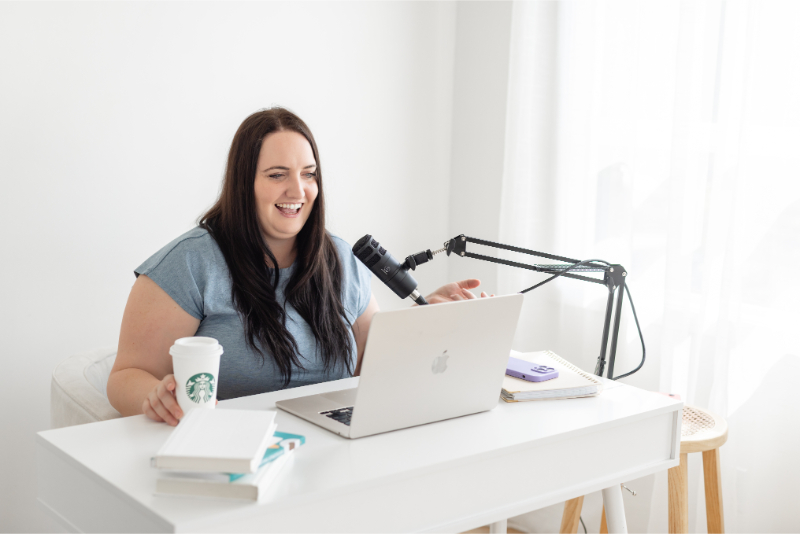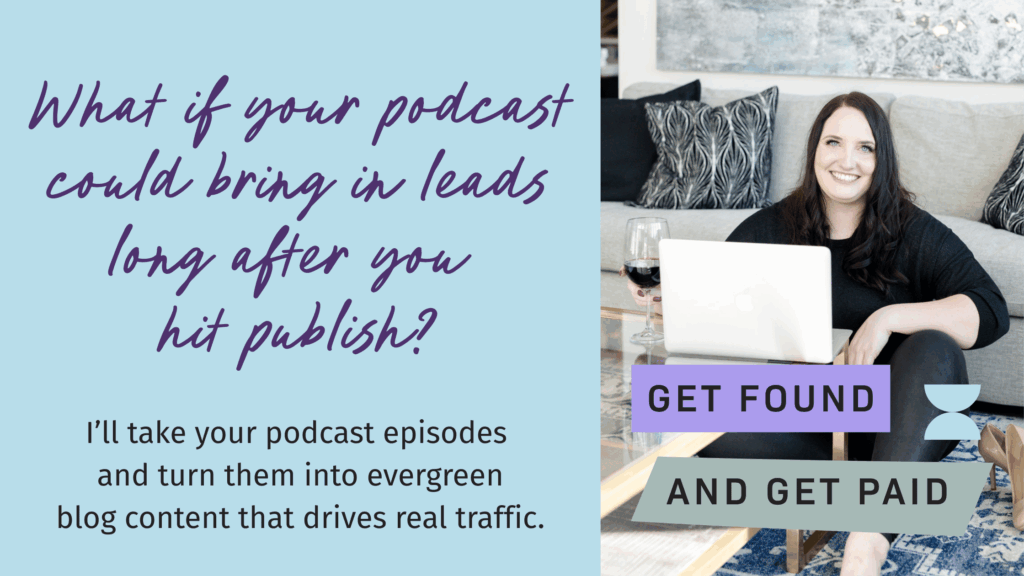You’re pouring your time and expertise into every podcast episode, but once it’s out there, it quickly disappears into the feed. If you’ve ever wondered how to repurpose podcast episodes into something that keeps working for you, you’re not alone. Your podcast deserves a second life, and it starts with your blog!
I’m Kara, a blog and Pinterest strategist for women entrepreneurs, and repurposing is kind of my thing. I believe your content should be working harder than you are. When done right, turning podcast episodes into evergreen blog content can help you boost SEO, grow your email list, and show up in search results months (or years) after you hit publish.
In this post, I’ll walk you through how to repurpose podcast episodes into blog content that actually gets read and drives results. From picking the right episodes to writing blog posts people want to click, you’ll learn how to stretch your content further, without burning out or sacrificing strategy.
If you’re tired of starting from scratch with every piece of content, this long-form blog approach will give you the visibility and longevity your podcast deserves. Let’s dive in!

Start with Strategy: Not Every Episode Needs a Full Recap
Before we dive into how to repurpose podcast episodes into evergreen blog content, we have to stop and get strategic. Not all episodes are created equal, and not every one deserves a full recap.
If your episode was more personal, like a behind-the-scenes update or casual chat, it might not translate well to a blog. And that’s okay! Blog content works best when it aligns with what people are actively searching for.
Instead, focus on episodes that:
- Tie into your evergreen offers
- Answer your most-asked client questions
- Include clear, actionable takeaways
- Match high-intent keywords your audience is Googling
More blog content is always better for SEO. But if your time or budget is limited, start with the episodes that do the most heavy lifting. A strategic blog recap can keep working long after an episode drops, and that’s exactly what we want.
And if you’re looking for a breakdown of the repurposing system I use in my own business and with clients, my private podcast dives even deeper into how to build it once and get found again and again.
Create a Blog Post That’s More Than a Transcript
Turning your podcast into a blog post doesn’t mean copying and pasting your transcript. Instead, shape the episode into something that delivers value for readers and ranks in search.
Here’s how to elevate your post beyond a transcript:
- Write an attention-grabbing introduction. Summarize what the episode is about and who it’s for. Make it clear why someone should keep reading. And don’t forget to introduce yourself and your business.
- Add headers to organize key points. Break up your content into logical sections so readers can skim and find what they need.
- Clean up the language. A conversational transcript can be messy. Edit for clarity, remove filler words, and format for readability.
- Focus on takeaways. Highlight the most valuable insights from the episode. Turn long explanations into bite-sized, actionable tips.
- Use internal links. Link to other relevant blog posts, especially ones that help the reader go deeper (like this one on growing your podcast with Pinterest and blogging).
By reworking your transcript into a thoughtful blog, you turn one piece of content into something that drives traffic, builds trust, and works for you long after the episode airs.

Highlight Search-Friendly Takeaways and Titles
Once you’ve chosen which episodes to repurpose, it’s time to shape that content for blog readers and search engines. That starts with highlighting the parts of your podcast that are most valuable, and most searchable. From episode titles to key takeaways, every element plays a role in helping your content get discovered.
Why Your Episode Title Matters
When learning how to repurpose your podcast episodes into blog evergreen blog content, start with the episode title. It’s your first chance to grab attention and show up in search. A vague title like “My Business Journey” won’t get clicks. But something like “How I Grew My Email List to 10K Subscribers in One Year” speaks directly to a problem your audience is trying to solve.
Use tools like Google autocomplete or Pinterest Trends to find high-intent keywords and naturally include them in your title.
Pull Out the Takeaways That Actually Rank
Next, highlight key takeaways from the episode that align with what people are searching for. Ask yourself:
- What problem does this episode solve?
- What questions does it answer?
- What would someone Google to find this?
Pull those answers into your blog post and phrase them in a way that feels natural, but optimized for SEO. Not sure how to do Podcast SEO? Check out this post this learn how to make your episodes more discoverable.
Use Clear Headers and Snippets
Use your blog post’s structure to your advantage. Make your headers descriptive and keyword-rich. This helps with searchability and improves the user experience. Add short summaries or “TL;DR” moments that let people quickly see what’s in it for them.
By shaping your content around real search behavior, you help new readers (and listeners!) find your content even if they’ve never heard of your podcast before.
Break it Down Into Digestible Blog Sections
Long blocks of text are hard to read, and they definitely don’t keep people on your site. When you’re learning how to repurpose your podcast episodes into evergreen blog content, structure is everything. Breaking your post into clearly defined sections not only improves readability but also boosts your chances of ranking in search.
Here’s how to make it easy for your audience to stick around:
- Use subheadings that mirror search terms. Think about what your audience is searching for and write H2s or H3s that reflect those exact phrases.
- Keep paragraphs short and purposeful. Aim for 2–4 sentences max. Large chunks of text feel overwhelming and are more likely to get skipped.
- Add a table of contents at the top. Especially for longer posts, this helps readers jump straight to the parts they care about, and signals that your post is comprehensive.
- Use bolding and spacing to guide the eye. Emphasize key points, highlight major takeaways, and break up the layout so it’s easy to scan.
Skimmable, strategic formatting isn’t just good Use experience, it’s a major SEO advantage. If your blog layout is cluttered or confusing, even the best content won’t convert. Not sure if your blog setup is helping or hurting your visibility? This post breaks down exactly why your blog might not be working, and how to fix it.

Use Content Upgrades or CTAs to Turn Readers Into Leads
Turning your podcast episode into a blog post is only part of the strategy. If you want that post to actually grow your audience and bring in leads, you need to give your readers a clear next step.
That could be:
- A freebie that expands on the episode’s topic
- A link to a related service or resource
- An invitation to binge your best content
And if you’re looking for a content upgrade that actually builds long-term visibility? My private podcast, Build It Once, Get Found for Months, is the best place to start. In just seven episodes, I’ll walk you through the same anti-burnout strategy I use for clients to get them booked out without relying on social media every day.
The goal of your CTA is to turn one-time readers into long-term fans. Whether it’s a behind-the-scenes resource, a next-step offer, or something bingeable and high-value, give them something worth clicking on.
Because when you pair valuable content with the right offer, your blog posts become more than just SEO boosts, they become part of your marketing engine.
Add Visuals for Pinterest and User Experience
When thinking about how to repurpose podcast episodes into blog content that gets seen and shared, don’t overlook the power of visuals. A blog post without images can feel overwhelming or dull, no matter how valuable the content is.
Adding custom graphics, branded quote images, or even simple section headers can break up long blocks of text and make your post easier to read. These visuals enhance the user experience and encourage your readers to actually stay on the page.
They also make your content Pinterest-ready. Every blog recap is an opportunity to create fresh pins that link back to your site, driving traffic long after your episode goes live.
After you repurpose podcast episodes into blog content, design Pinterest graphics with compelling titles or key takeaways to give your blog posts a longer shelf life. This strategy helps brand-new audiences find your podcast through search-based platforms.
Even just a couple designs per post can make a big difference. If you’re already investing time into blogging, why not make sure that content is working harder for you?

Final Thoughts
Knowing how to repurpose podcast episodes into evergreen blog content is one of the smartest ways to extend the life of your show, attract new listeners, and drive traffic to your site. But you don’t have to do it all yourself.
If you’re ready to finally hand off your podcast blog posts to someone who gets content strategy and knows how to repurpose podcast episodes into search-friendly, lead-generating blogs, this is the service for you. My team and I write blog posts that don’t just summarize your episodes, we turn them into evergreen marketing assets that help your business grow.
Want to keep learning more? Listen to The Kara Report podcast for honest conversations about sustainable marketing, visibility, and content that works long after it’s published.
You can also follow along on Pinterest, catch up on my latest Youtube videos, and connect with me on Instagram for even more tips on how to create marketing that lasts.
And when you’re ready to get started? Reach out here. I’d love to support you!